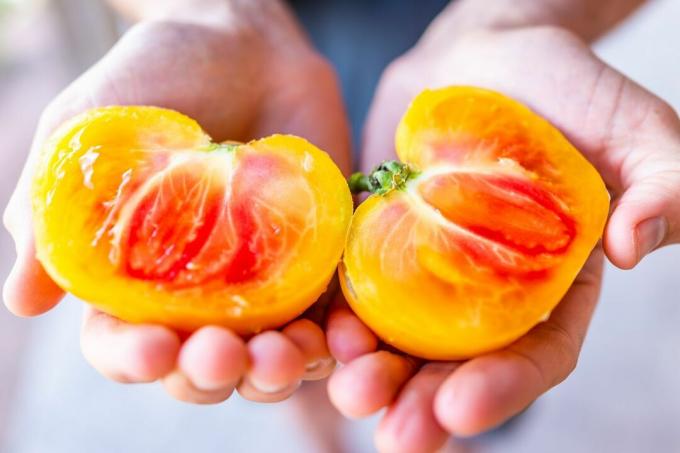The 'Oaxacan Jewel' tomato is one of the very early varieties with large fruits. Everything you need to know about growing Oaxacan Jewel is here.

The pretty 'Oaxacan Jewel' is a real eye-catcher in midsummer with its flat, round, yellow to orange marbled fruits. We present the ancient, high-yielding tomato variety in the profile.
contents
- Oaxacan Jewel: Wanted Poster
- Origin and history of the beefsteak tomato
- Description and taste of the tomato variety 'Oaxacan Jewel'
- Planting and caring for the Oaxacan Jewel: This is something to keep in mind
- Harvesting and using Oaxacan Jewel tomatoes
Oaxacan Jewel: Wanted Poster
| synonyms | 'Joya de Oaxaca' |
| fruit | beef tomato; orange-red marbled |
| the taste | sweet, juicy, aromatic |
| maturing time | early |
| growth | Stick tomato, up to 150 cm |
| location | Glasshouse |
Origin and history of the beefsteak tomato
The 'Oaxacan Jewel' originally comes from Mexico and is said to have existed there before the 16th century. century to have been cultivated. So it's a really old and historic strain that's still popular to this day. Also known as Joya de Oaxaca. Incidentally, Oaxaca is the name of one of the 31 states of Mexico and is located in the south of the country.
Description and taste of the tomato variety 'Oaxacan Jewel'
The 'Oaxacan Jewel' is just 150 centimeters high, so it remains very small for a beefsteak tomato. Instead, she puts her power into numerous large fruits. Its leaves are like potatoes, which makes it easy to distinguish them from other varieties. The orange-red marbled beauties ripen as early as July and are therefore among the earliest varieties. When ripe, the smooth to slightly ribbed fruits become very soft and have a pleasant texture. The taste of the 'Oaxacan Jewel' is sweet, juicy and aromatic. As an old variety, this early beefsteak tomato is of course also firm to seed. She lets herself out homegrown tomato seeds plant again next year.

Planting and caring for the Oaxacan Jewel: This is something to keep in mind
Like most beefsteak tomatoes, the 'Oaxacan Jewel' feels most at home in a greenhouse. Here it gets a lot of heat and reliably ripens early in July. From the beginning of May you can place young plants of the 'Oaxacan Jewel' in the greenhouse. To do this, dig a deep hole and place the plants in it. Remove any leaves that would now be underground so that only a third of the 'Oaxacan Jewel' is showing. It is best to fill the planting hole with a nutrient-rich substrate such as ours Plantura organic tomato & vegetable soil, and press lightly. The tomato now develops many roots underground along the stalk and absorbs water and minerals better. Finally, stick a stick next to the plant to support it later and give it a good watering.
The 'Oaxacan Jewel' is slow-growing and therefore very easy to care for. However, if some side shoots form, you should tomato. Beefsteak tomatoes bear best on the main shoot, the weaker side shoots often cannot hold the high weight of the fruit. In June you should use a mainly organic long-term organic fertilizer like ours to support fruit formation Plantura organic tomato fertilizer, bring out. The granules are applied to the surface and decomposed in the soil. The nutrients reach the roots evenly and over weeks. In this way, the fruits are optimally supplied and both over-fertilization and deficiency of the plants are prevented.
Harvesting and using Oaxacan Jewel tomatoes
The 'Oaxacan Jewel' is suitable as a beefsteak tomato for fresh consumption directly from the vine. Their unique taste comes into its own in salads and snacks. Of course, the pretty tomato is also suitable for preserving soups and sauces or for preserving during the cold season.
Tomatoes need a lot of nutrients in order to bear plenty of fruit throughout the summer and not suffer from a deficiency. what to do Fertilizing tomatoes should be considered, you can read about it here.
